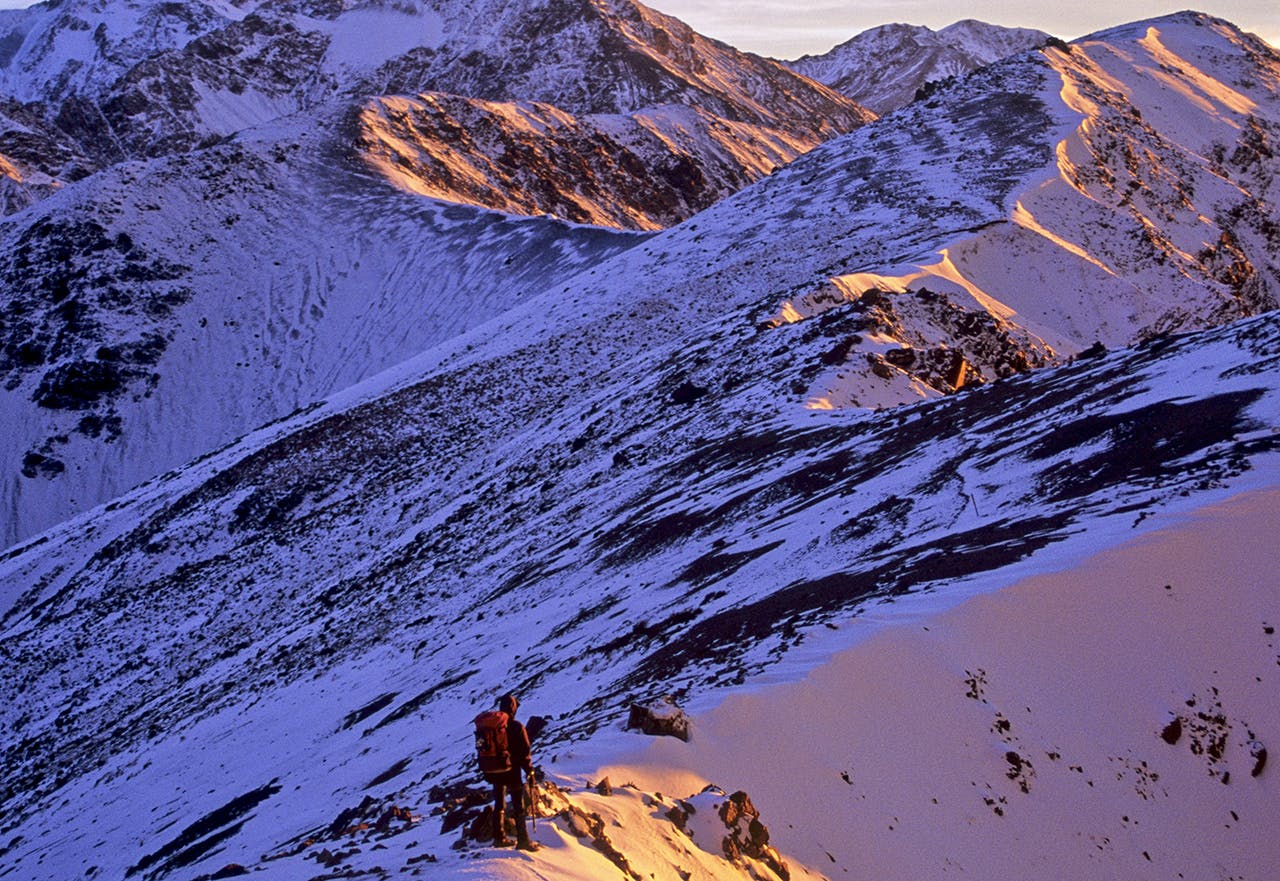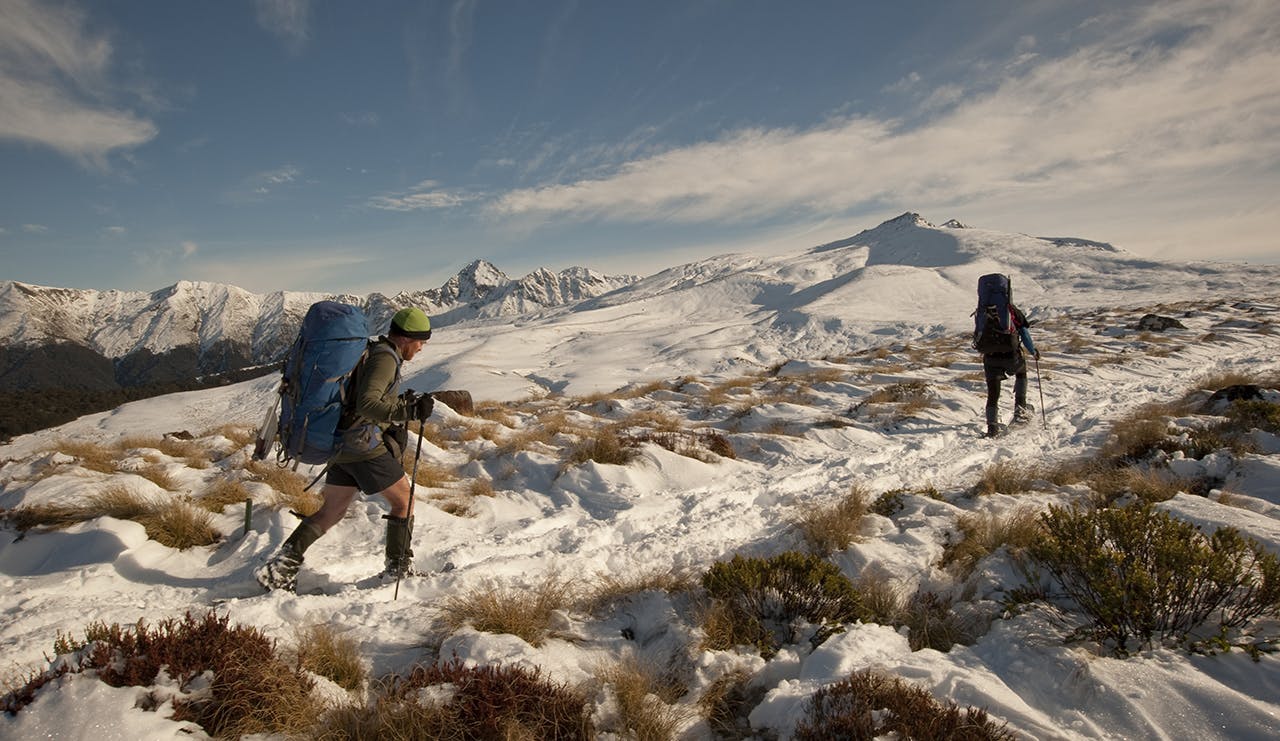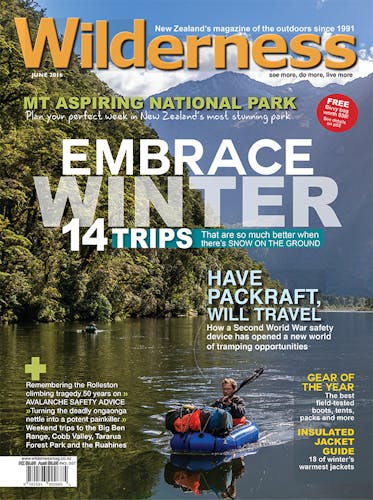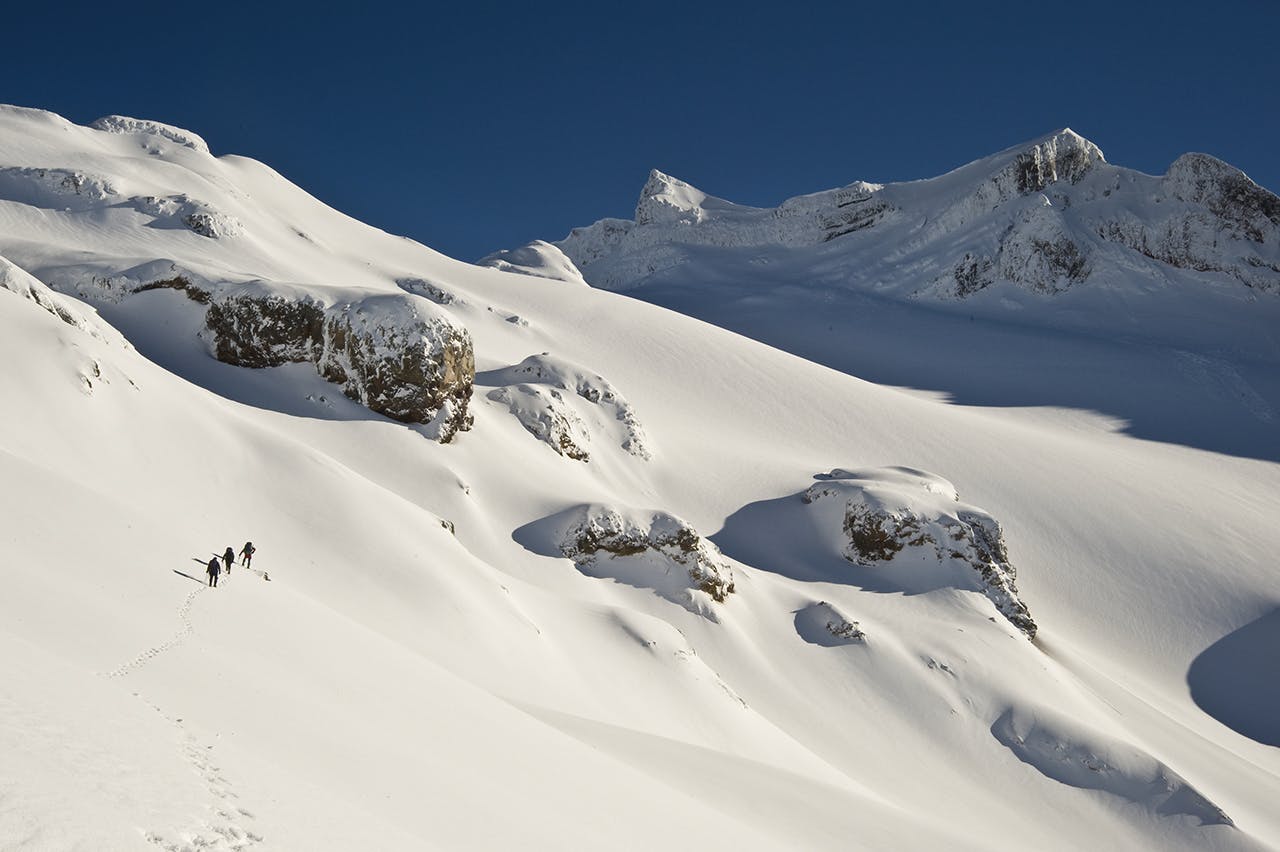Crisp days, snow on the tops, no sandflies, fewer people, clearer air and haze-free views; winter has lots of merits. There is also the joy of your boots crunching through snow, and at day’s end the guilt-free warmth of a good fire in a hut.
It’s colder, of course, so you need to carry warmer clothing. The days are shorter, and avalanches can pose a risk, but provided you make allowances, these should not be impediments to a safe trip.
Here are seven tramps that are better done in the colder months.
1. Round the Mountain Track, Tongariro National Park
The track around Mt Ruapehu gets considerably less use than the Tongariro Northern Circuit, but in many ways exceeds it for sheer variety. There are many waterfalls on the western side, including the exquisite creamy cascades near Mangaturuturu Hut; the Matterhorn-like profile of Girdlestone Peak; the yawning desolate Wahinoa Valley; the strange patterns of the Rangipo Desert; and the historic Old Waihohonu Hut. And of course there’s the ever-present dominance of Mt Ruapehu itself, which in winter lies under a thick snowy coat.
The exposed nature of the track above the bushline makes this potentially lethal in the wrong weather, but during a good spell of settled, crisp weather it’s a great winter tramp. The huts are tidy, well-stocked with firewood and set in excellent locations.
While summer trampers often complete the circuit in as little as three days, a more leisurely 4-5 days should be allowed during winter’s shorter daylight hours. The circuit overlaps the Tongariro Northern Circuit on its northern edge, on the section between Waihohonu Hut and Whakapapa.
One winter, I completed a satisfying alternative by heading off-track on the section between Rangipo and Waihohonu huts. We walked to Tukino Ski Field, climbed past Whangaehu Hut, up the Mangatoetoenui Glacier to Ruapehu’s Summit Plateau and Crater Lake, then ended with a long sidle across the Mangaturuturu Glacier to Turoa Ski Field.
Access Ohakune Mountain Road, Whakapapa, Bruce Road, Desert Road or Tukino Ski Field Grade Moderate Time 4-5 days.
2. Kaweka Flats Bivouac, Kaweka Forest Park
My first tramp into this area was in winter and the snow-mantled mountains, crisp winter air and small orange bivouac all left an impression.
The eastern Kaweka Range has been ravaged by erosion, the result of fires and over-grazing in the past, and the scars from these assaults are all too apparent during summer. But in winter, snow hides the mistakes of the past and lends the range a height and majesty denied it in summer.
The track to Kaweka Flats Biv begins from Makahu Saddle at the end of Whittle Road, which reaches an altitude of 1000m, so in winter you’ll often encounter snow on the drive in. The track wends its way north at the base of the many spurs running down from the main Kaweka Range, passing through vegetation of surprising diversity. It crosses a few small streams before a final haul up onto the Kaweka Flats. The two-bunk dog-box biv faces the range.
Access Whittle Road, accessible from Puketitiri Grade Moderate Time 2.5-3hr each way.
3. Sawtooth Ridge, Ruahine Forest Park
I’d traversed the Sawtooth Ridge a couple of times in summer conditions before first clapping eyes on it under a heavy coating of winter snow. The sight staggered me; steep gullies, snow-plastered, the sharp ridgeline etched crisply against a cool blue winter sky, and a sense of scale that belied its actual height. I asked a few people to identify the location of the resulting photographs, and most guessed somewhere in the Southern Alps. I’m yet to traverse the Sawtooth itself in winter (a challenge requiring mountaineering skills and excellent conditions), but have approached it from both ends.
The north end of the Sawtooth is a peak called Ohuinga (1686m), which can be reached either via Rosvalls Track to Black Ridge and Tarn Biv, or from Hinerua Hut.
The south end is a pyramid-shaped peak called Tiraha (1668m), most easily reached from Howletts Hut. This cosy shelter, with its efficient woodburner, makes a fine winter destination, perched on Daphne Ridge at 1350m. Access is via Daphne Hut and spur, either up the Tukituki (a pretty cold option in winter that involves wading up the often-frigid river) or via the Moorcock Stream Track that begins from Kashmir Road. Howletts is in great condition, thanks to the efforts of the Heretaunga Tramping Club, which owns the hut. It offers great views of Black Ridge, the Tukituki Valley and the Ruahine foothills, but you have to tramp further along Daphne Ridge and partway up Tiraha to get a decent vista of the Sawtooth itself.
Unless the snow is particularly soft, you’ll probably need crampons and an ice-axe.
Access Kashmir or Mill Roads Grade Moderate-difficult Time 2-3 days.
4. Mt Fyffe, Ka Whata Tu o Rakihouia Conservation Park

Walking a wintry Mt Fyffe, . Photo: Shaun Barnett/Black Robin Photography
Mt Fyffe is a well-located hut, with grand views over Kaikoura Peninsula and the Seaward Kaikoura Range. In winter, these views are even better, and as a bonus, the hut has a good woodburner. Access is up a long winding vehicle track, which offers a good challenge to fit mountain bikers, and a slow, steady plod for trampers. Beyond, the track continues to the summit of Mt Fyffe (1602m).
Access Postmans Rd, Kaikoura Grade Moderate Time 4.5-6hr to summit.
5. Welcome Flat Hut, Westland National Park
Welcome Flat has a lot going for it: a big hut, great hot pools and views of the Sierra Range, which explorer Charlie Douglas once reckoned looked as if a giant of little skill had hacked it out with a bad file.
The other thing going for Welcome Flat in summer is a lot of tourists. Why not avoid the crowds and try a winter trip? No sandflies, the hot pools possibly to yourself and snow hanging on the Sierra Range at impossibly steep angles.
Access SH6, south of Fox Glacier Grade Moderate Time 6hr to hut.
6. Kepler Track, Fiordland National Park

Tramping the Kepler in winter is a unique way to experience this Great Walk. Photo: Shaun Barnett/Black Robin Photography
I’ve walked the Kepler in summer and snowshoed it in winter. Which was better? In many respects, winter wins hands down: fewer people, near-empty huts, and often you’re high above the clouds lying low over Lake Te Anau.
From the superbly positioned Luxmore Hut, you can gaze across the South Arm to the wintry-white Murchison Mountains. However, this is not a trip for the inexperienced or ill-prepared; Iris Burn Hut is a frigid, sunless place in winter, and the risk of avalanches on the tops can be significant: two Canadian trampers died on the track in July 2015.
In the right conditions, tackling the track in snowshoes is a great experience. Allow extra time for deep snow and don’t proceed beyond Luxmore Hut unless you are confident that the avalanche danger is minimal.
Access Te Anau Grade Difficult Time 3-4 days
7. Rakiura Track, Rakiura National Park
Friends of mine once tackled the North West Circuit in winter and found the mud, extremely short daylight hours and hard frosts made for a tough trip. With that in mind, I chose the much shorter and easier Rakiura Track one winter and found it a delightful experience.
In winter, the circuit offers no sandflies, few people and some enjoyable coastal scenery often rendered in warm tones by the low winter sun. The track follows the coastline to Port William Hut on the first day, then crosses a forested ridge to reach North Arm Hut on the second day. It then sidles beside Paterson Inlet to end at Halfmoon Bay.
Access Halfmoon Bay, Stewart Island Grade Easy Time 2-3 days








